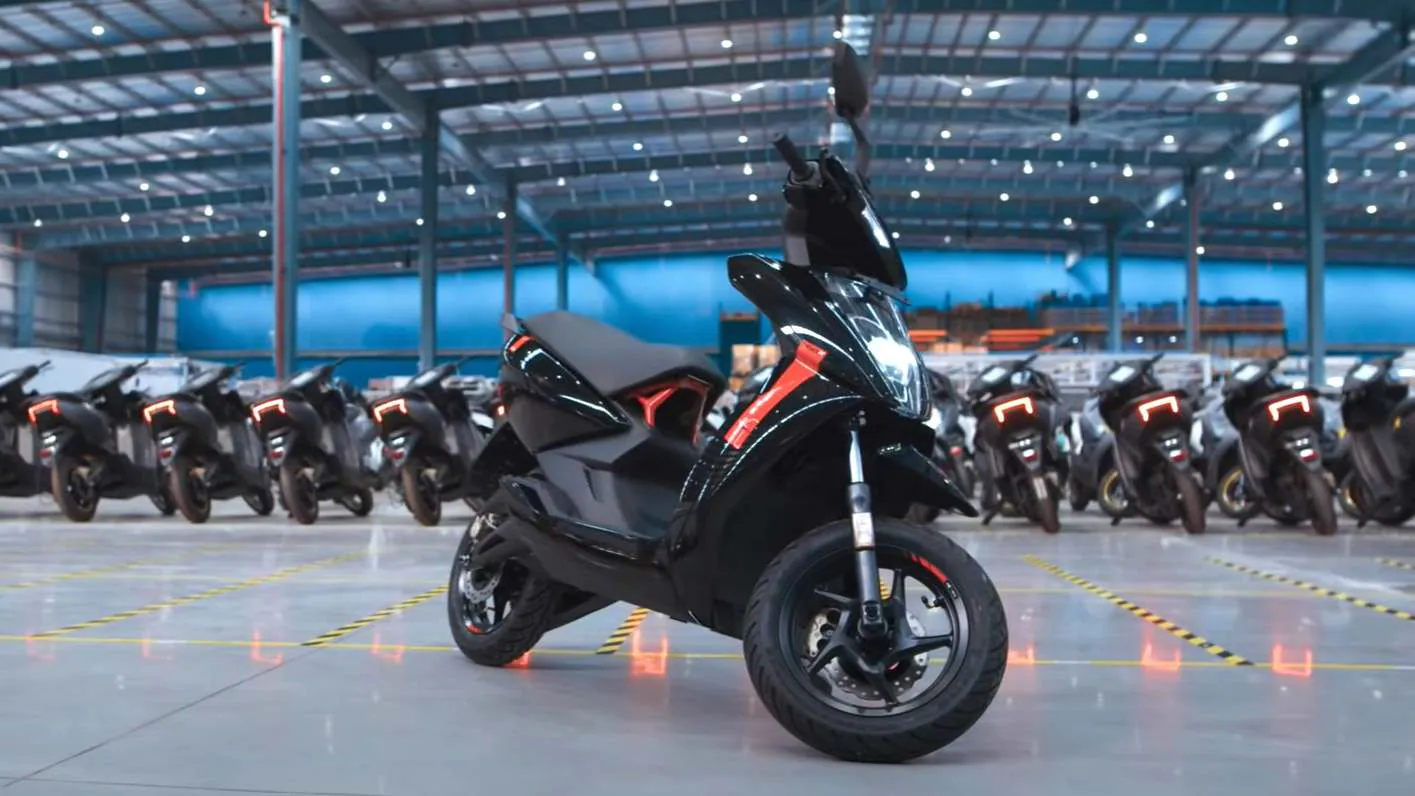Karan PradhanMar 19, 2021 16:21:07 IST
I am by no means a completionist. It’s best to start things off with that admission. And that I’ve never actively sought to ‘Platinum’ video games.
While this is by no means an effort to knock the people who do aspire to complete every single side-mission, find every single collectible, complete the game on every single difficulty level and use every single weapon or piece of armour available while doing so, it’s just not for me.
That said, I appreciate games that make me want to dig deeper into their respective universes and their lore, explore a variety of side stories, better acquaint myself with their array of characters and travel across the various terrains on offer. To invoke a cliché: I like being tempted off the beaten path by games, and not trophies.
It’s why I thoroughly enjoyed the likes of Horizon Zero Dawn, The Witcher 3: Wild Hunt, the Yakuza games, the Arkham games and even Cyberpunk 2077. Another game that sits high up on that list is last year’s Persona 5 Royal (referred to henceforth as Royal).

Screen grab from Persona 5 Strikers
An expanded version of Atlus’ Persona 5, Royal is a compelling RPG that adds 20 to 30 hours of story content to the original game and fleshes out a couple of side characters with fascinating backgrounds and story arcs. And while the game can be completed without maxing out stats, relationships or completing all the side quests, it’s the story and the very interesting presentation of teammates, side characters and the universe at large that compels you to do so much more than the basic story.
That’s probably why I found myself spending around 120 hours on it last year.
The events of Persona 5 Strikers (referred to henceforth as Strikers) — the English version of which released worldwide last month — take place right after Persona 5 ends, and in doing so, leave out the story of Royal. Which, for the most part, is absolutely fine since there’s already so much to build on.
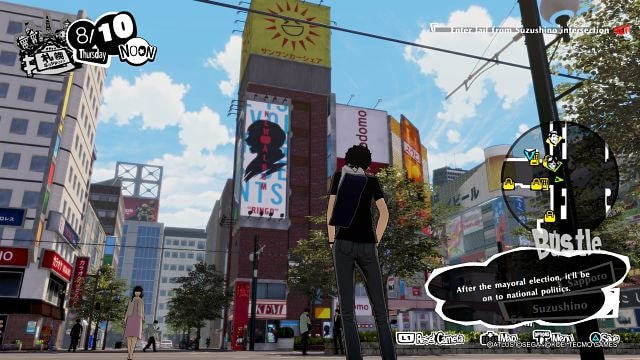
Screen grab from Persona 5 Strikers
Road-trippin’
Very briefly, Persona 5 and Royal tell the story of the Phantom Thieves, a bunch of schoolkids led by protagonist Joker, who learn to resolve the problems of the real world by crossing over into the Metaverse — a realm abuzz with all sorts of supernatural goings-on that is constructed by subconscious fears, desires, anger etc — and fighting manifestations of personal (theirs and those of others) demons.
Having conquered the mind ‘Palaces’ of a variety of antagonists in the original game, Strikers sees the gang on summer vacation and pitted against a different type of threat: Mind ‘Jails’. The difference between these two types of cognitive mazes is a plot point, so I won’t go into too much detail, suffice to say that this shift demonstrates a more mature and less binary good-or-evil side of the Phantom Thieves.
If you’ve never played a Persona game before, here’s Polygon’s handy guide to what it’s all about.
If you’ve never played Persona 5 or Royal, then you need to turn around right now. Strikers doesn’t so much reward familiarity with its predecessor as much as demand it. Playing the latest offering before the games that came before it will be the ultimate exercise in wasting time. Mark my words.
However, if you are familiar with either, you’ll find the reunion with Joker, Ann Takamaki, Haru Okumura, Yusuke Kitagawa, Ryuji Sakamoto, Makoto Niijima, Morgana and Futaba Sakura comfortingly familiar. The tone and tenor of conversations (keeping it casual even when discussing serious matters) also return and make Strikers seem less like a new game than a new chapter in the lives of these school/college students… and a cat.
Having balanced schoolwork, socialising and all the headaches of being a teen with battling supernatural forces in the Metaverse in Persona 5, Strikers finds the gang readying for a well-earned summer vacation. And just when they thought they were out of the business of stealing hearts, they’re pulled back in, to poorly paraphrase Al Pacino.
This new quest for Jails, instead of Palaces from the last time out, sees the Phantom Thieves embark on a picturesque jaunt across Japan, taking in such destinations as Kyoto, Osaka and Sapporo. All of these locations are given their own unique look, feel and charm, and I was particularly fascinated by the way the Dotonbori Entertainment District in Osaka was portrayed in Strikers compared to its portrayal in Ryu Ga Gotoku Studios’ Yakuza games (where it is known as Sotenbori, for some reason).
Speaking of the Yakuza series, there’s this snappy little reference to a recent release that shows up towards the beginning of the game that I quite enjoyed:
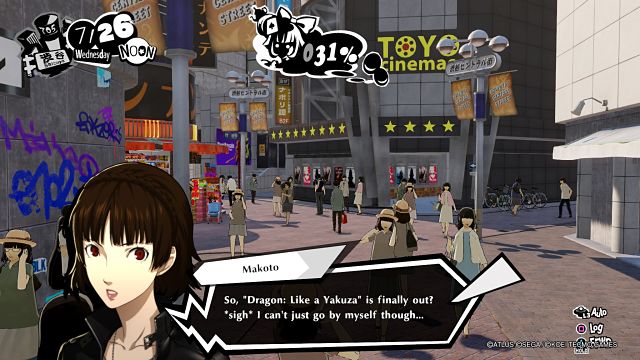
Screen grab from Persona 5 Strikers
The Jails you encounter across the country, much like in the Palaces from Persona 5, are customised thematically around the principal level antagonist’s (or mini boss) personality. A lot like the Palaces, once again, each Jail presents a different challenge and a different formula to unlocking it.
Perhaps the most endearing part of the road trip is the Phantom Thieves’ fascination with food and the lengths to which Strikers goes to indulge it. From characters passionately discussing local delicacies and side missions where you have to procure those to a new crafting component that entails collecting recipes and then cooking them, this game takes its food extremely seriously.
What’s new?
Not long after you’ve taken in the familiarity does everything suddenly start to feel different. The ward of Shibuya in Tokyo feels less densely packed than before with far less to do and far fewer people to meet. The game seems to be giving you less space and time to explore and instead, appears to be pushing you along from one checkpoint to another.
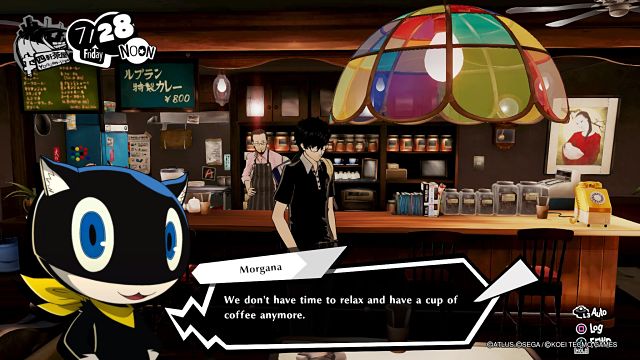
Screen grab from Persona 5 Strikers
Your friends are already your friends (yes, it sounds ridiculous, but bear with me), which means there’s no need nor way to firm up your bonds with them individually. Dig a little deeper and you’ll find NPCs with whom you can interact to be at a premium and side activities virtually non-existent.
Finally, there’s the core gameplay. If you’re at all familiar with the Persona series of games, you’ll know that developer and publisher Atlus doesn’t tend to shy away from less-than-conventional spinoffs. Rhythm-based dance games are particularly popular with Persona 5: Dancing in Starlight, Persona 4: Dancing All Night and Persona 3: Dancing in Moonlight all being received quite well. A break from the routine — in this instance, turn-based combat — within the same setting is always welcome in gaming. An excellent case in point is Super Puzzle Fighter II Turbo that sees the likes of Ken, Ryu and Chun-Li go head-to-head against each other in a variant of Tetris. It’s highly recommended by the way, so long as you can find it somewhere.
In a rather less drastic departure than dance or puzzles, Strikers trades in the turn-based combat of its predecessor for a more hack-and-slash or Musou (a genre of games popularised by the Dynasty Warriors series of games that sees you hammer an attack button to scythe down walls and walls of enemies) approach. That’s not much of a surprise considering developer Omega Force (a division of Koei Tecmo, the force behind a majority of Musou games) is on board this time alongside Atlus’ own P-Studio.

Screen grab from Persona 5 Strikers
A reskinned Dynasty Warriors or Persona 5 Lite?
The good news is that Strikers isn’t Dynasty Warriors in Persona 5 clothing. There’s enough to keep fans of the original or Royal interested and invested.
The bad news is that there isn’t enough Persona 5 in Strikers to make it feel like a genuine successor to one of the finest turn-based RPGs in recent times.
Therein lies my biggest problem with Strikers: It’s just not Persona 5 enough for my liking.
I’ll be the first to admit that I’m no Persona or Shin Megami Tensei (the franchise to which the former belongs) veteran and that Royal was the first game of the series I’ve ever played. However, it hooked me from the start and didn’t let go until long after the credits had rolled. This is more than I can say for Strikers and there are a handful of reasons why.
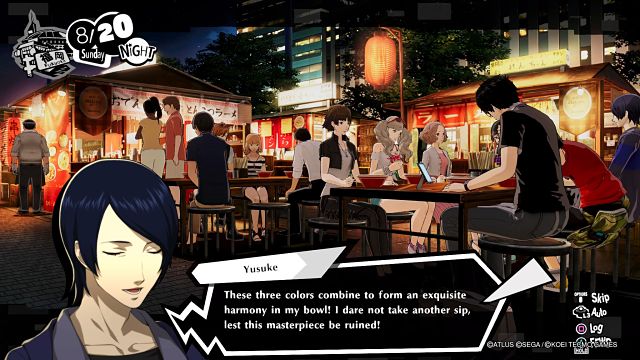
Screen grab from Persona 5 Strikers
The first is undoubtedly the story, the characters, the setting and the treatment. Persona 5 was blessed with a diverse set of characters, complete with their own strengths, weaknesses, pathos, quirks and charm. Getting to know them better was one of the most compelling aspects of the game. Persona 5 also gave you the opportunity to apportion your in-game time on improving relationships with certain characters rather than others, which aside from adding to the story, granted you special boosts and buffs when those favoured characters were in your party. The overall narrative was engaging, plot progression and twists (which, it must be said, weren’t always all that unpredictable) were logical, and the anime style of the whole package was most appealing.
The latter aspect remains thankfully untouched. However, with Strikers, relationships with your old pals are pretty much set in stone and the only improvement possible is in terms of combat and armour upgrades. New characters Sophia and Zenkichi Hasegawa are useful additions and their stories and motivations are reasonably well fleshed-out. Unfortunately, all of the relationship-building exercises and side missions are gone this time, and replaced by extremely basic fetch or kill quests (collect x number of A or kill y number of B types) in the Metaverse. Furthermore, while Sophia and Zenkichi enjoy some character development, your old buddies are granted very little of it over the course of the game.
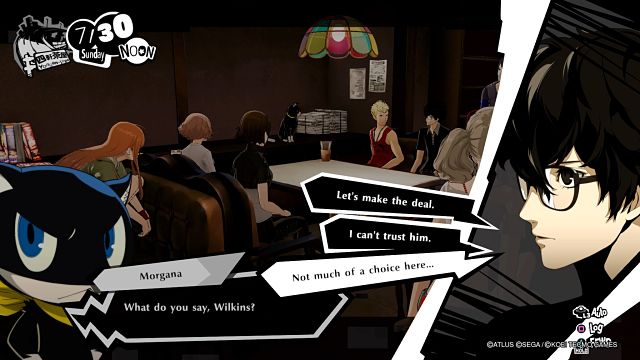
Screen grab from Persona 5 Strikers
The second is the combat. One of the most compelling aspects of Persona 5 was the turn-based combat system and its interplay with the Pokémon-esque collection of various Personas (each with their own elemental strengths and weaknesses). While the quest for new Personas is still present in some form, it feels less deliberate and more an outcome of luck or random number generation. The combat, however, is where things take a real turn for the worse. Outwitting and outmanoeuvring bosses or mini-bosses in Persona 5 was an intriguing challenge.
Identifying the right element with which to attack an enemy and then stringing together a series of optimal attack soon turned into an art — something I often found myself marvelling about for hours afterwards. The hack-and-slash combat of Strikers employs a bit of strategy (in terms of when to use special moves, which teammate to include in your party and the choice of Personas with which to equip your character). But comparing the level of strategy in Strikers with that of Persona 5 or Royal is like comparing Ludo with chess. From a visual standpoint, the Musou style coupled with the sort of animation employed in Persona 5 games makes for a very messy and cluttered onscreen experience, particularly when taking on particularly large hoards.
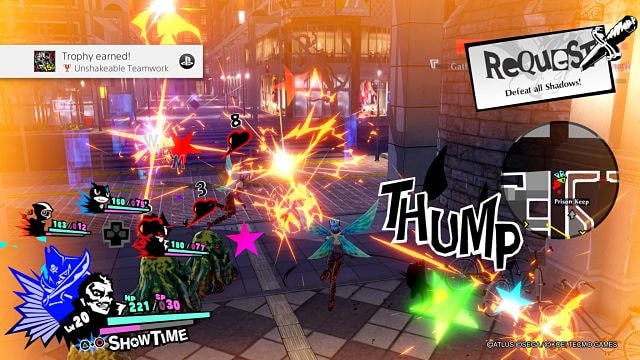
Screen grab from Persona 5 Strikers
The third crucial element of what made Persona 5 (and Royal) so memorable was that it was a time management sim half the time. Tethered to a tight school timetable, you were tasked with making the most of each day in terms of whether you should spend time with a particular teammate or improve a particular skill or tackle side quests. There was enough time to do a lot, but not nearly enough to do it all. Strikers doesn’t face that challenge because everything moves along in a very linear fashion.
Time isn’t limited and the day only ends once you’ve decided to return to the RV or accepted a dialogue option to call it a day. Plus, there simply isn’t enough to do and there’s only a couple of times you get to select a teammate with whom you want to spend some time. This, in any case, is cosmetic and has no effect whatsoever on what happens next. While it was the characters and story that got me hooked, it was the time management aspect of Royal that was most addictive.

Screen grab from Persona 5 Strikers
The fourth and final of these reasons is the writing and dialogue. I’d be remiss not to point out that the writing felt incredibly bloated in Royal. The game was blighted by far too much exposition and repetition. I got it the first time, Atlus! I didn’t need to be told 14 times how crucial the next mission was! In that regard, Strikers feels crisper and snappier with the level of exposition and repetition greatly stripped down.
However, in the process, what’s also lost is the sense of natural conversation (even though, as mentioned earlier, the tone and tenor remains unchanged) between characters. Dialogue feels a bit stilted at times and at others, it feels like a few parts of the discussion have been edited out as characters draw conclusions without the necessary evidence. Unless, of course, this evidence was gathered off camera, which would make no sense considering the random small talk that came before the conclusion.
A missed opportunity
When I first heard about Persona 5 Strikers, a part of me hoped it might be a carrom-based game —which still sounds like an awesome idea. They’d gone down the dance game route, so why not carrom? I’ll leave you, gentle reader, and the good people at Atlus to mull that one and weigh its pros and cons.
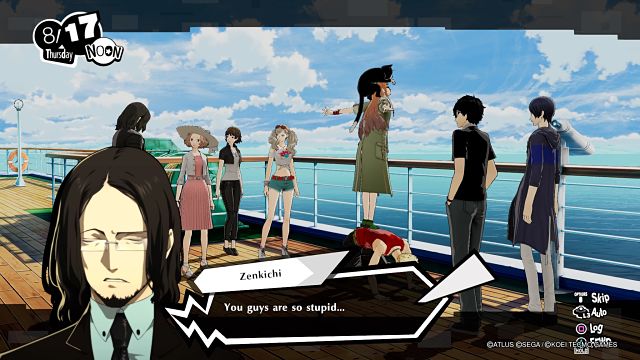
Screen grab from Persona 5 Strikers
What Strikers provided was a great opportunity to go in a new direction with an extremely accomplished game as background. All that was really required was to build on its predecessor’s strengths and introduce enough new elements to keep things nice and fresh. I have to mention that Strikers is by no stretch a bad game, and I say that after having played through it twice before putting down my thoughts. It’s just not very good and the quite unfavourable comparison with Persona 5 and Royal unfortunately brings it down another few pegs.
That I didn’t feel compelled to finish any more side missions than strictly necessary or try and explore very far off the beaten path led me to believe I’d missed something crucial, and so I embarked on a second playthrough. Very little changed apart from me skipping cutscenes because I knew what was coming next.
The Musou approach to a Persona game isn’t a bad one per se, but it needs some more variety because it tends to go stale very quickly. The story suffers from the same issue, with tedium creeping in all too frequently. Additionally, the overall plot feels very limited compared to that of Persona 5 story and more often than not, I found myself wanting segments to wrap up just so we could move on, rather than because I wanted to know what would happen next. All in all, Strikers will represent, for me, an interesting crossover of styles, but an ingloriously missed opportunity to take a great game in a new direction.
Oh, and the decision to do away with the DARTSLIVE3 minigame? Criminal, I tell you. Absolutely criminal.
Game reviewed on PlayStation 4 Pro. Review code provided by the publisher.

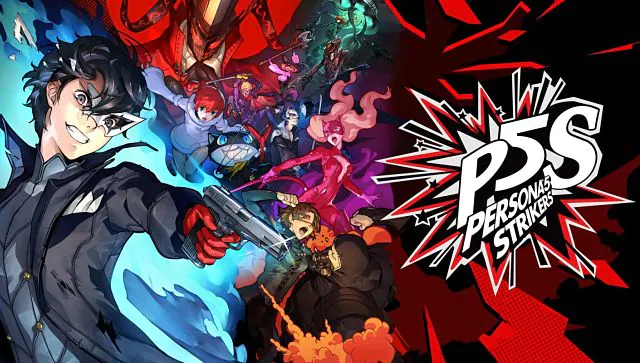



![Read more about the article Twitter restricts numerous high-profile accounts in India following ‘legal demand’ [Update] – TC](https://blog.digitalsevaa.com/wp-content/uploads/2021/02/GettyImages-1129362195-300x200.jpg)
